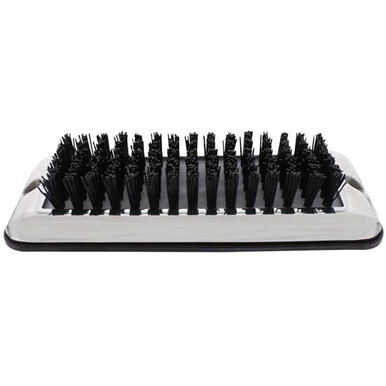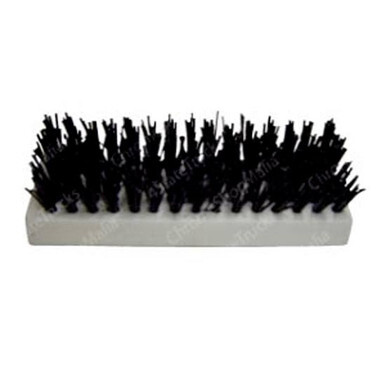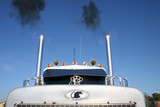Semi Truck Boot Brush Guide: Does it Really Keep Your Cab Clean?
Step-mounted boot brushes are aftermarket cleaning devices that attach to a truck’s exterior steps; this allows you to scrape off any mud, snow, or debris from your boots before entering the cab.
Boot brushes have a sturdy metal housing mounted on or beside the actual step, which is filled with coarse bristles.
As the driver climbs in, they can wipe their footwear on the brush, removing dirt and grime. Some drivers choose to make their own.
One anonymous user, “droy,” said he created his own version of a boot brush by mounting a leftover mud flap onto the step plate. “I found a white mudflap with the ‘astroturf’ looking stuff attached to the back of the flap” (The Truckers Report, 2009)
Sure, it can be that simple. Just create a makeshift boot brush. But there’s a downside. Buying a well-designed, chrome-polished boot brush is an affordable accessory that’s worth every penny.
Why Get a Boot Brush for Your Truck?
Although a boot brush isn’t a must-have item, it offers a few great benefits:
#1. Keep Your Cab Clean
By scraping off mud, sand, snow, or oil before stepping inside, drivers prevent build-up of grime on floor mats and pedals. You reduce how often the floor needs to be swept, vacuumed, or shampooed.
#2. Safety & Traction
Clean boot soles have better grip on pedals and steps, reducing slip hazards. Some step brushes (and especially step mats) provide a textured, non-slip surface on the step itself. In winter, brushing off snow and ice can prevent icy clumps from making steps slippery. Overall, it’s an accessory that helps you get some secure footing and pedal control.
#3. Added Professionalism
By keeping mud out, a boot brush can help drivers comply with cleanliness guidelines. It also projects a professional image – many operators take pride in a clean rig, and not tracking dirt inside contributes to that.
#4. Preservation of Cab Materials
By minimizing dirt and grit on the floor, boot brushes can extend the life of interior finishes. Gritty mud acts like sandpaper on mats and carpeting. Keeping debris out helps prevent wear-and-tear on flooring and reduces the chances of abrasive particles causing damage. It can, potentially, lessen the clogging of HVAC filters by dust and dirt.
#5. Convenience
A step-mounted brush makes it quick and easy to wipe off debris from your sole, even if you forget to do it ahead of time.
Installing a boot brush is an easy, low-cost accessory to upgrade your cab to make it cleaner and safer.
Stainless Steel vs. Chrome Aluminum Boot Brushes
Step-mounted boot brushes come primarily in two material constructions for the housing/frame: stainless steel and chrome-plated aluminum.
Both are popular. Here’s a comparison between the two.
Stainless Steel Brushes

A lot of products will use stainless steel (often 430-grade) for the housing and mounting brackets. Stainless steel is valued for its strength and durability – it can withstand heavy foot pressure and harsh weather without bending.
It’s also highly resistant to rust and corrosion, so road salt and moisture won’t easily degrade it. Drivers in snow or coastal areas often prefer stainless for its longevity.
These units usually have a polished or brushed finish that complements other stainless accessories.
Pros: Extremely sturdy, long-lasting, rust-resistant; can be polished for shine.
Cons: Slightly heavier than aluminum; typically a plain metal look (though can be shiny), which may not match chrome trim exactly.
Cost can be moderate: many stainless boot brushes range around $40–$60 each, which is quite affordable for the robustness provided.
Chrome Aluminum Brushes

A popular alternative are boot brushes made of aluminum, often with a chrome-plated or highly polished finish. These have a bright chrome-like shine that appeals to drivers who love chrome accents. Aluminum is lightweight and naturally immune to rust (it won’t rust like steel; at most it oxidizes slowly).
This means even if the chrome plating gets scratched, the underlying aluminum won’t red-rust. Aluminum brushes tend to be lighter-weight and corrosion-proof, and many have eye-catching designs.
Grand General’s famous “Boot Caddie” is an example – it has a “chrome aluminum housing with replaceable brush” and reversible sides (one plain, one with a logo) for style.
Pros: Lighter weight; excellent corrosion resistance; often more decorative (chrome plating, logos, even LED lights in some models).
Cons: Aluminum is softer than steel – under extreme pressure or a heavy kick it may bend or dent more easily. Chrome-plating, if used, can chip or peel over time if not cared for.
Also, the shiny chrome finish might require polishing to keep its luster. In terms of cost, chrome aluminum models are similar or slightly more – typically $40–$70 for a standard unit, with specialty versions (e.g. with LED lights) costing more.
To sum it up, steel frames offer maximum durability (great for heavy-duty use) while aluminum frames resist corrosion better and save weight. For most drivers, both materials perform well – the choice often comes down to aesthetic preference (matte stainless vs. mirror chrome) and brand availability.
It’s worth noting that both types use heavy-duty nylon or polypropylene bristles that are UV-resistant and replaceable in many models, so the cleaning performance is similar. Many manufacturers even offer brush refills in various colors (black, blue, red, etc.) to replace worn bristles or customize the look.
Quick Tip on Using Boot Brushes
If you’re frequently working in winter conditions with lots of road salt, buy stainless steel as opposed to chrome.
A small chip in chrome could invite corrosion on non-stainless metals beneath. You could also just buy the material that matches your existing exterior chrome or stainless steel.
Quick Comparison of the Top Boot Brush Products
Top Boot Brushes for Semi-Truck Steps — Comparison
Installation Details and Step Compatibility
Installing a boot brush is generally a straightforward DIY task, but it does involve some considerations:
Universal Fit: Most aftermarket boot brushes are designed to fit standard semi-truck steps, which are usually in the 16″ to 24″ width range.
The brush units themselves are around 7–8″ long, so they can mount on various step types (deck plates, fuel tank steps, battery box steps, etc.) as long as there’s a flat surface or flange to bolt onto. Before you buy one, measure the surface area of the mounting spot.
Universal brushes come with adjustable brackets or simply a flat base that you drill through, so they accommodate different truck models (Peterbilt, Kenworth, Freightliner, Volvo, etc.).
The Clean Cab strap-on brush can even wrap around round tube steps or foldable RV steps, due to its flexible strap design.
Boot Brush Mounting Instructions
Compatibility: Boot brushes are generally “one size fits all” for any make of semi-truck. They are commonly seen on Freightliner Cascadias, Kenworths, Peterbilts, Volvos, Macks – you name it. You just need to find a flat spot on the step. Some trucks have perf-grated steps for slip protection. Even so, you can still mount a brush by drilling through the perforated pattern or on the side lip of the step.
Universal brushes often have slim profiles (2–3″ tall) so they tuck nicely on the step edge. If your step is part of a battery box, ensure there’s clearance underneath for the bolt nuts (usually not an issue). In rare cases, if a step is very full (ex. a toolbox step covered in diamond plate), you might need to get creative with placement.
Multiple Brushes: Some drivers install two brushes - one on each side of the step.
Maintenance: Installation is largely “set and forget,” but it’s good practice to periodically tighten the mounting bolts (during routine inspections) and clean out the brush itself. You can use a hose or pressure washer to clean the brush frame and bristles.
Overall, installing a boot brush is a moderate DIY job that most operators or mechanics can handle easily. The key is proper positioning and secure attachment – once mounted, these brushes can endure years of abuse, scraping boots daily at 70+ mph winds and all weather.
Customer Reviews and Feedback Trends
Boot brushes for semis, though small accessories, have garnered a lot of positive feedback from drivers.
Here are some common themes from reviews and user reports:
- Effective dirt removal
- Quality, durable design
- Easy to install
- Stays secure on a vibrating truck (some high-priced options like the “Sym-Mat” use zip ties for extra sturdiness)
Negatives or Issues:
- Bristle wear and tear (requires replacement)
- Missing mounting hardware
- High Prices (common on high-end options like LED Boot Caddie)
A lot of drivers mention that a boot brush is one of the “best accessories” to add, simply because it saves them from constantly cleaning the cab floor.
Price Range & Where to Buy Your Next Boot Brush
Outfitting your truck with a boot brush is really inexpensive, and there are options to fit different budgets:
It’s common sense. Well-known brands cost more. Higher quality base materials and bristles cost more. At the end of the day, it’s about what works and what doesn’t.
Whether you get a high-end artificial grass step mat, ranging between $80 to $90, or a functional bare-bones boot brush unit (metal housing with some bristles), ranging from $20 to $60, both can get the job done.
You can also find a middle-of-the-road price point in a no-drill cab brush for $35 on Amazon. Cheaper products might mean you’ll have to replace them more frequently over time.
Replacement brush inserts (depending on your make/model design) cost about $15–$25 if you ever need one.
Where You Can Buy Boot Brushes
First and foremost, you can get them at 4 State Trucks or other aftermarket sellers.
Physical Truck Stops: If you’re on the road, you can usually stop off and get a boot brush in a nearby truck store.
Manufacturer Websites: You can order them directly from the manufacturer, like United Pacific, Grand General, and more.
Buying Tip: Prioritize reputable sellers – either established truck accessory stores or known brands on marketplaces.
Once purchased, that’s it. No ongoing upgrades. You might replace your brush insert every few years.
Whether you get a gleaming chrome caddie or a robust stainless scraper or a full step mat – this small, affordable accessory can really be worth your while.
Recent Posts
-
Peterbilt vs Mack: Choosing Between Rugged or Classic Styles
Let’s do a quick breakdown of Mack trucks vs Peterbilt trucks Mack is naturally the cheaper, more af …2nd Jan 2026 -
The Ultimate Guide to DPF Filters & DEF Systems on Semi Trucks
Let’s break down how to maintain peak emissions performance and avoid excessive repairs. In this gui …30th Dec 2025 -
How to Choose the Best Refrigerator for Your Semi Truck
Every OTR truck driver needs reliable cooling for food and beverages on long haul drives. That's whe …26th Dec 2025 -
Haul of Fame: Inside Ivy’s Poison – The Wild 1986 Peterbilt 359 That Refused to Die
If you hang around truck shows long enough, you start hearing the same names over and over. Some are …19th Dec 2025 -
The Ultimate Guide to Custom Semi Truck Upholstery (Everything You Need to Know)
Almost any custom show truck prioritizes quality interior upholstery material and stitch design, be …16th Dec 2025 -
What Does the FASS Fuel System Do?
Want to protect and clean your diesel fuel system in one go? The FASS (fuel air separation system) i …12th Dec 2025 -
Semi Truck Muffler Guide
Need to lower your exhaust and engine noise, but aren’t sure what muffler to get? We offer Pittsburg …5th Dec 2025 -
Custom Underglow Light Setups on Semi Trucks
If you're looking for a way to dramatically enhance the look and presence of your semi truck at nigh …28th Nov 2025 -
Common Myths and Mistakes When Buying Aftermarket Semi Truck Parts (Ultimate Guide)
Cost, convenience, and make/model fitment are the top priorities when it comes to buying aftermarket …18th Nov 2025 -
Haul of Fame: Tony's Custom Retro W900 Kenworth
Tony Huttenstine is a seasoned owner-operator. Over the years, he has poured enormous time, money, a …14th Nov 2025














